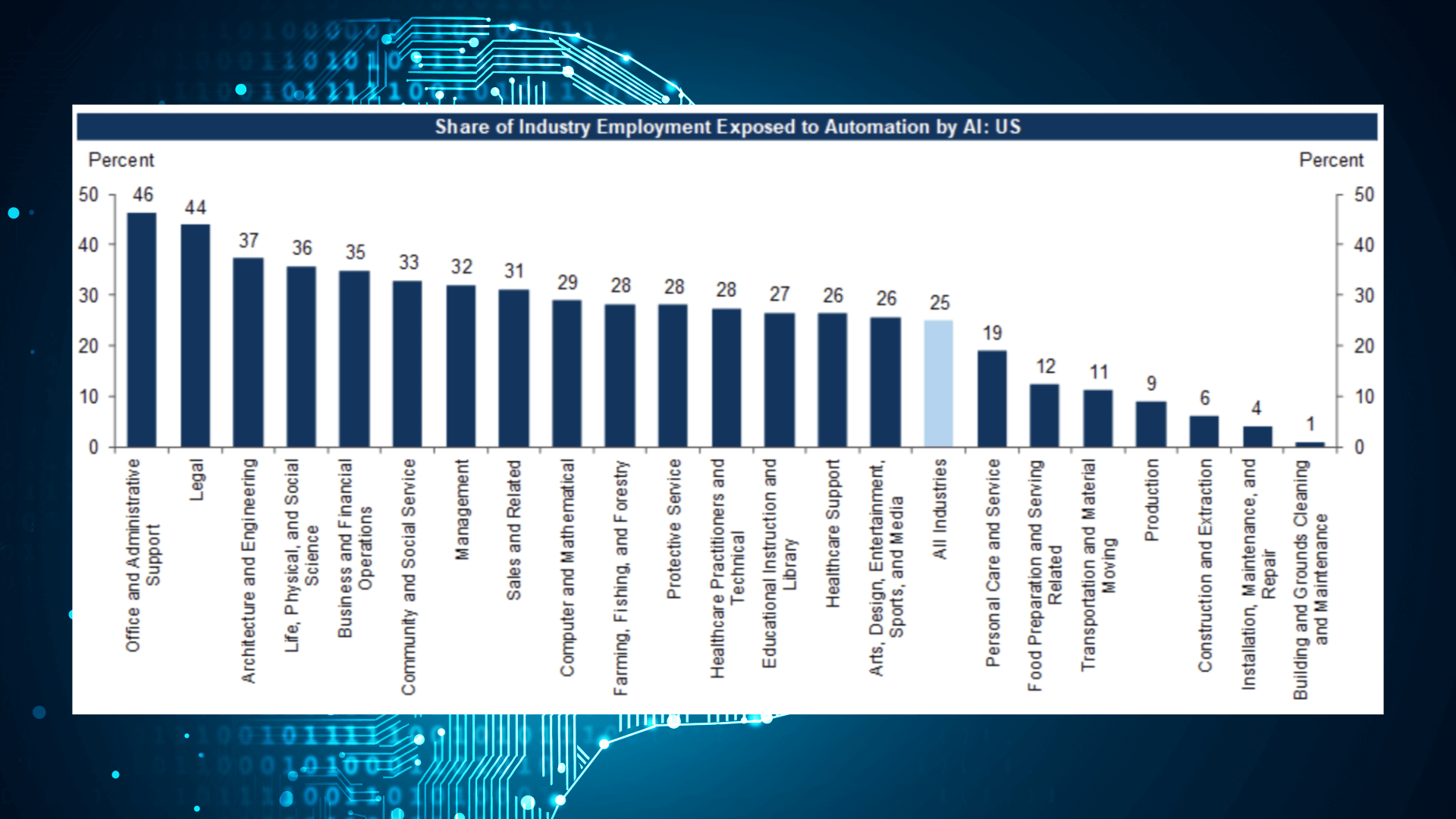
Before the mid-20th century, a “computer” referred to a person who performed mathematical calculations by hand. Good luck finding that gig today. Likewise, elevator operators, “pin boys” who reset bowling pins between frames, and telephone switchboard personnel have all gone the way of the dinosaurs. In a dynamic economy, “creative destruction” is a cliché. Now, artificial intelligence is writing a new chapter in this story.
The good news about technological change is that we have a large collection of historical data from which to conclude that while certain occupations may disappear, jobs in general will remain. Creating goods and services from scarce resources has always required some form of human involvement, innovation and creativity. Despite what some may say, I don’t think this will change in the age of artificial intelligence.
In fact, technology often creates more jobs than it destroys. A McKinsey report (Jobs Lost, Jobs Gained: Transforming the Workforce in the Age of Automation) estimates that 3.5 million jobs in the United States have been lost to personal computers and the Internet. But about 19.3 million other jobs were also added, for a net gain of 15.8 million jobs.
We don’t know how many jobs AI will disrupt in the coming years, but there’s probably no business of any size that won’t be affected.a study Vansenborn Large companies in the US and UK estimate that each employee spends approximately 19 days per year on boring, repetitive tasks. In theory, artificial intelligence has the potential to alleviate this problem and make work more interesting and efficient.
Unlike previous technological revolutions, this one may undo the worst disruptions to the highly skilled workforce. Content writers, coders, investment advisors, and many other knowledge workers will need to adapt. That means businesses and the investors who back them also need to grow and change. This article will try to clarify how to do this. This is the second part of a series of articles, starting with “How to invest in artificial intelligence” and ending with “How artificial intelligence can improve the investment process.”
Artificial Intelligence promises to increase productivity across the enterprise
Cars moved people faster than horses and carriages. Computer spreadsheets can help you complete the task in a fraction of the time required with manual ledgers. As disruptive technologies spread through the economy, history has proven that the ability to do more with fewer resources can raise average living standards and open up new opportunities for profit and advancement. But there will always be winners and losers as old ways of doing things are shaken up.
As far as artificial intelligence is concerned, there will undoubtedly be many areas of disruption.recent Wall Street Journal article Saying that artificial intelligence “is expected to impact every activity that involves touching a keyboard.” That may sound like hyperbole, but consider the chart below from a recent Goldman Sachs report.

Image source: Goldman Sachs report titled “The Potentially Huge Impact of Artificial Intelligence on Economic Growth” (association) Add background
If charts like this one are correct, then workers in nearly every industry will need to learn how to work with and leverage artificial intelligence, which in many cases will require at least some level of retraining. However, workers who make the transition quickly and successfully are likely to earn higher wages and have greater opportunities for advancement than before.recent Brookings Institution Post The dynamics of this shift are summed up nicely:
“Workers who are able to complement new automation and perform tasks beyond the capabilities of machines generally enjoy higher pay. However, the situation is even worse when machines can replace workers performing similar tasks…It is very important that both on the job and on the job Or elsewhere, workers with access to more education and training can learn new tasks and become more complementary to machines. For example, while robots replace unskilled workers on assembly lines, they also provide support for machinists, advanced welders and and other technicians who maintain the machines or use the machines to perform new tasks create new jobs.”
Overall, about 65% of U.S. senior executives surveyed by auditing and consulting firm KPMG (association) expects generative AI to have a “high or very high” impact on their organizations over the next 3-5 years. But 60% of respondents claimed that implementation would take another year or two due to barriers such as talent, governance and the sheer scale of the task of retraining workers in the above manner.
That said, there are already examples of AI changing the type of work done every day at private equity portfolio companies. At this stage, the impact is most noticeable in white-collar fields involving repetitive administrative tasks involving text output. For example, “Wall Street Journal” reports The law firm Allen & Overy is increasing productivity by using an artificial intelligence tool called Harvey to research and write first drafts of documents, then handing them off to humans to complete the finish line.
Generative AI is also seeping into customer service. Call your bank or home insurance company’s support line and you may find yourself talking to a chatbot named Charlie or Amelia, who can handle basic queries without the need for a human agent. Likewise, advances in artificial intelligence are transforming the lending industry, speeding up and improving the loan application process by taking over more basic data entry and customer support functions, and parsing new patterns to help qualify borrowers beyond traditional credit score metrics.
With this in mind, it’s easy to see how generative AI could quickly analyze consumer spending trends like a market researcher, or a family’s financial health, income prospects, and retirement goals like an investment advisor. Radiologists and optometrists can also shift the basic diagnostic aspects of their jobs to AI, freeing up more time to work with patients. Even just within the next few years, the possibilities are endless.
What this means for private equity portfolios
Imagine traveling back in time to 1992, before Mosaic, the first widely used web browser. I don’t know about you, but I would probably use my “cordless” phone to call my broker (they were mostly human back then) and place an order to buy a few select stocks, not realizing that in ten or two years , the entire process takes just a few clicks on the screen in your hand. We are in a similar period now. Companies that effectively incorporate artificial intelligence into their business models will gain tremendous value, just like those that leverage the Internet effectively.
Imagine a private equity fund acquires a business that develops a (non-AI-based) plan to make salespeople 10% more effective while eliminating some redundant back-office positions. Adding an AI strategy to the plan could hand over significant additional tasks to AI. If this frees up another 20% of salespeople’s time, the star performer in the portfolio will be a comet, with returns potentially 2-3x what was expected before the advent of artificial intelligence. Multiply this number by the large number of companies that could adopt artificial intelligence in the next few years, and you start to get a sense of the possibilities.
Here’s another way to think about it. A McKinsey study estimates (association) Six out of ten jobs are currently automatable at least 30%. This research was done before ChatGPT! Now, instead of imagining those employees sitting on their hands, imagine them spending that time on less routine, less automated tasks, thereby increasing profitability.
New revenue streams are also possible for businesses already in private equity firms’ portfolios. AI solutions developed in-house can be sold to other companies or AI developers. Likewise, proprietary data sets can be sold or licensed to AI developers eager for new data to train algorithms. However, as we discussed in our previous article, investors should be cautious about investing time and money in developing custom solutions when off-the-shelf products from tech giants like Google and Microsoft may be sufficient for a company’s needs.
Above all, it’s important to remember that the richest rewards will accrue to the first and best adopters of the technology. Once a new generation of artificial intelligence becomes ubiquitous and the paradigm shifts, the huge gains associated with more productive sales teams, better customer service offerings, and more will quickly be lost to competition.
Conclusion: Learning from Artificial Intelligence
The further implementation and development of artificial intelligence may represent the most significant social change in our lifetimes. So when artificial intelligence understands us, we should understand it too. We can’t process data as fast as we can or discern patterns, but our flesh-and-blood brains can still do things that AI can’t, like think conceptually about the future of AI and where it can (and can’t) get. The highest and best utilization. It would be naive to think that jobs won’t be lost to artificial intelligence. But it also has the potential to create new, more productive roles that pay higher wages for many people and hopefully make them feel more engaged at work than they do now.
From a business perspective, a more productive and engaged workforce is an attractive prospect for profits and returns. But it’s important to remember that, for almost all companies, while the work of artificial intelligence itself may seem a bit like magic, it can’t be achieved with just the wave of a magic wand. Choosing where and how to leverage artificial intelligence requires careful research, planning and retraining of a company’s workforce, recruiting new roles and skills over time. For example, Allen and Overy’s rollout of AI includes what they call “a lot of change management, a lot of governance around AI. We always have an expert involved.”
If this sounds scary, it shouldn’t be. As with any major change, it’s best to start small and use proven tools that are already available. Look for “low-hanging fruit” opportunities in your portfolio, where AI algorithms can free up employees to engage in higher-value activities, such as big-picture thinking and handling more complex customer issues.these examples Opportunity type From drafting basic content and emails to summarizing meetings, translating documents, managing customer service inquiries, and expediting keyword research, jobs abound.
Remember, you need to have clear policies in place about when and how employees can leverage publicly available tools like ChatGPT, especially if confidential or proprietary information is involved. Most importantly, don’t bury your head in the sand. If generative AI seems like a watershed moment, you may find yourself in a world you don’t understand when you take it out.
Have you come across interesting potential investments related to artificial intelligence or novel uses of the technology in private equity investing or portfolio company management? Please contact us at info@asimplemodel.com or through one of the following channels and tell us more – As the discussion around artificial intelligence continues, we are always looking for new opportunities and examples to include.






